W. Edwards Deming: Optimization Expert
Greatest statistical thinker in the last 2000 years.
His aim was to bring about a new kind of world.

The key to unlocking your company’s full potential lies in adopting the Deming philosophy – a proven approach to management that has transformed organizations worldwide.
Not that it can be (nor should be) summed up quickly, however;
I used to summarize Deming’s philosophy for improving business as:
Raise your baseline, lower your variance
(Note: There is a point when reducing variation becomes detrimental.)
Today, I summarize Deming’s philosophy for the improvement of business as:
Employee empowerment with Statistical Process Control (SPC)
Deming had an extraordinary impact in our world. However, it was not until 1980 that he was “discovered” in America: through the White Paper Report below, which was in response our National Crisis: a small island of our enemies with no natural resources was producing superior products at HALF our cost.
A couple decades earlier, Japan and its infrastructure was in total ruin. After WWII, they accepted our help rebuilding by asking for an unknown statistics professor in New York. Within a few short years, Deming was given credit for the “Japanese economic miracle.” This was deemed one the hidden turning points in world history.
Just a hunch: If he can turn around a country, he can also transform your little business. Unless you enjoy learning the hard way, I encourage you to discover why his work is more important today than ever before?
If you know nothing about Deming, maybe start here:
Within minutes of discovering Deming’s Philosophy I read something that will haunt me the rest of my life:
From page six in his book Out of the Crisis:
What is the world’s most underdeveloped nation? With the storehouse of skills and knowledge contained in its millions of unemployed, and with the even more appalling underuse, misuse, and abuse of skills and knowledge in the army of employed people in all ranks in all industries, the United States may be (still) today the most underdeveloped nation in the world.
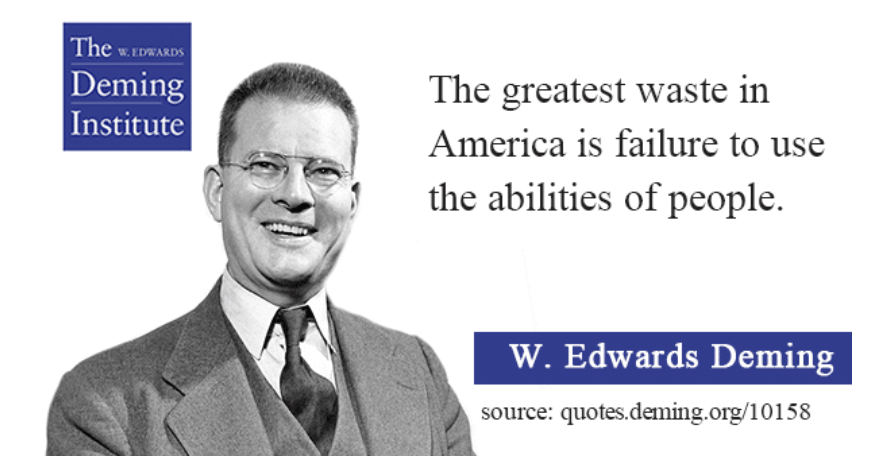
Directly correlated, a frequently used quote that resonates:
“People are entitled to joy in work.”
The reasons, ways and methods willing workers are denied joy and dignity in their work (and education) are too many to list here.
The nasty truth; employees cannot even speak honestly with their employers about the topic…
I am guessing you have never thought about it: You and everyone else: That you are acting under the influence of a management philosophy. In fact,
There is a battle for control over management in the western world. The Two opposing world-views:
(Frederick Taylor’s view is leading our world to economic disaster.)
Neo-Taylorism
Frederick W. Taylor assumed that developed systems could be optimal. Experts and managers would instruct workers in all matters.
Based on Newtonian physics; supposing the world around us is deterministic, like a Swiss Clock. Proposing a computable and measurable relation between what is happening presently, and what has happened at any time in the past. A chain of action and reaction that can be projected into the future. An assumption of causal relationships.
Supposedly, the only flaws in this “optimal system” arise from people not understanding, not following procedures, from improper supervision or poor motivation.
Deming
W. Edwards Deming showed that all systems contain flaws, and that by using statistical methods to find and remove these flaws, we can continuously improve our systems.
Based on Quantum Physics, which still baffles many experts. Quantum mechanics tells us that relationships between events may be nonlinear and impossible to predict
The information needed to set up optimal systems is unknown and unknowable.
There are an entirely different categories of flaws that have nothing to do with human performance, even though they are often attributed to workers.
Picture this:
Old School:
Traditional Management:

This company follows traditional top-down management practices. Leaders determine how the work is to be done and give orders to their staff accordingly. Individuals, functional groups and departments are treated as independent entities under centralized control. Pay and promotion are determined Individual performance according to a set of predetermined criteria. Employees are ranked and encouraged to compete with each other.
New School:
Actual Leadership:

Superior companies are managed as an interactive system where people and functional teams depend on each other. Supervisors are not expected to have all the answers. They rely on front line worker’s to share their workplace knowledge and take an active role in improving their work processes. All employees know they are part of a team culture pursuing common goals and solving problems together to move the company forward.
Another way to look at it:
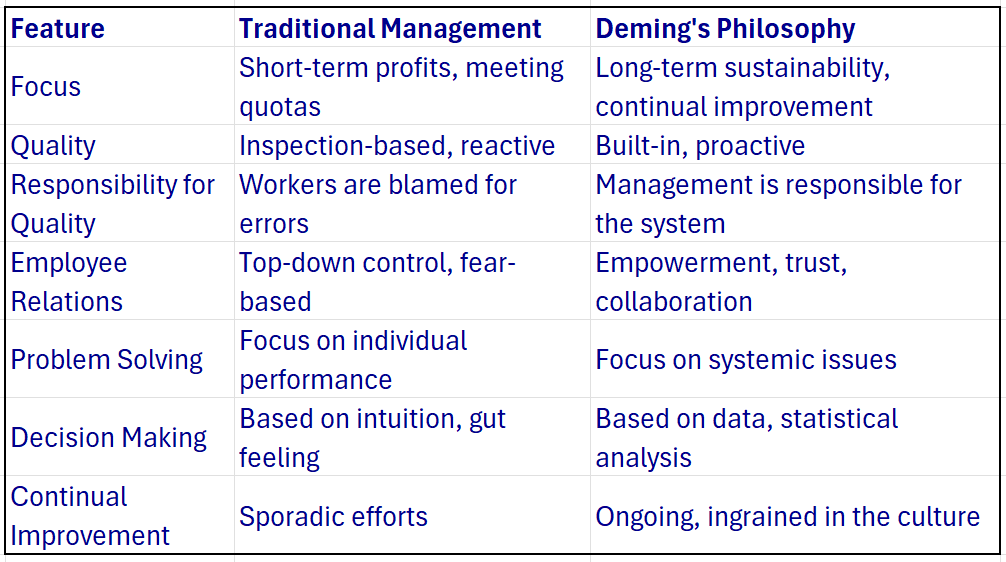
One route enables us to realize the potential of our nation’s enormous energy, brain power and inventiveness. The other does not.
Taylorism assumes that workers will put forth the least effort possible. How about, instead, we pretend like humans are an integral part of the process and not a machine part to be swapped out. People can be a wealth of ideas and insight…
We live in a world where management chides, questions, berates, rewards, punishes, warns, stimulates, incites, goads and otherwise tries to motivate people to meet their goals that are often vague and/or impossible to achieve (To be the best, with zero defects).
This nonsense usually starts at age (3) three. In grade school, we begin rating and ranking people, inducing fear, competition and scarcity. Effectively driving out cooperation, creativity, intrinsic motivation, any and all joy in learning.
What is the aim of our schools? Is it to learn? Or, is it to get a good grade? To pass you through to the next grade? If the aim is to learn, why do we not teach HOW TO LEARN? And why the cookie cutter approach? Why the one size fits all approach to learning despite our various learning styles?
Rather than rant – you can study Deming on your own – his approach is so different from what we are used to. In the school example, he insists we abolish the grading system. Why?
Again, the reasons are too numerous to list here. Aside from it being 100% subject (based on opinion, not fact), yet this idea is so striking! The ONLY reason, is because these methods are so ingrained in our consciousness that we don’t even question them. Like an epiphany,
Once you see it, you cannot unsee it. Once you make the connection, you cannot understand why other people “don’t get it.” It is like lifting the blinders that have always shielded you from the truth. For example;
Competition: Why do we promote competition between people and departments working for the same company? Classic example: Paying salespeople commissions. Intuitively we know cooperation is a matter of our survival. Yet we drive it out of school and business like it is the plague? Not yet convinced?
We love to rate and rank. Students get grades. Employee get merit reviews. Test this: Try rating, ranking and performance reviewing your wife and kids and tell me how it works out for you. Why then do we bring these off the wall concepts to work? Idk, but
When working on a project at home, how much smoother is it than doing that same project at work? At home, we have greater control over the system. For example, I want to build a patio. I know the end result. I choose the materials. I decide which tools to use, when, where and how to use them. I don’t have “work arounds” where a manager is ignoring my every “trivial demand.”
I could rattle off 100 examples from my own experience. Multiply this by the millions of employee people throughout the U.S.. This is madness. If you are the business owner and you have no idea what I am talking about – your frustration is a matter of perspective. I got a hunch your interior and exterior realities are no aligned.
You need outside perspective! You will not find innovation anywhere else.
Even though you would rather chop off a finger than implement all 14, here you go:
Deming’s 14-point theory for management: Print this pdf
The characteristic way of management we have been taught in the Western world is to take complex systems, break them into parts, manage each part as well as possible. Problem is,
These “parts” are forced to compete against one another for resources. Everyone suffers.
How many managers are forced to optimize their own department at the expense of the system? How many look after their own career rather than doing what is best for the company overall?
If your company’s aim is long-term productivity gain:
There is no alternative to continually improving your product and service.
(Actual Improvement, not speculation: Systematically testing using scientific methodology, NOT copying other company processes and continuously trying different things on a whim…)
If this makes sense, you have to understand:
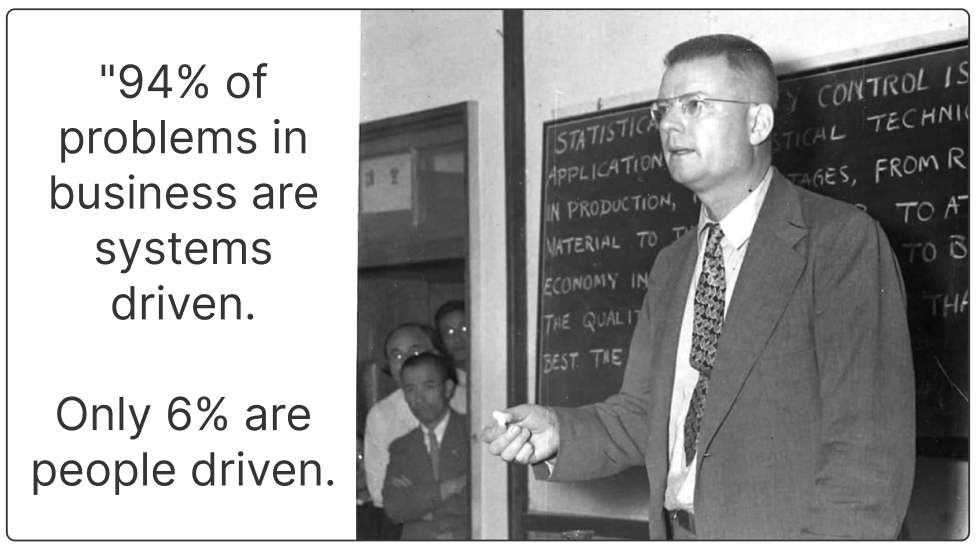
The first step in improving your product and service, is by improving the process that creates your product and service. Deming was able to demonstrate:
Most troubles and most possibilities for improvement add up to proportions something like this:
- 94% belong to the system (the responsibility of management)
- 6% are attributable to special causes.
(94/6 is commonly accepted. Actual percentages are more extreme – I believe more like 98/2, however I have not yet verified…)
No amount of care or skill in workmanship can overcome fundamental faults of the system.
Yet, how many workers get blamed for management’s ignorance and sloppy thinking?
I heard Apple has employees memorize this:
“I cannot make a mistake. The mistake that occurs is always the result of a system or process my manager has implemented incorrectly.”
Consider the implications…
The “Deadly Diseases” standing in the way of our transformation:
- Lack of constancy of purpose
- Emphasis on short-term profits
- Evaluation of performance, merit ratings, annual reviews
- Mobility of management, job hopping
- Management by the use only of visible figures, with little regard to figures that are unknown or unknowable.
- Excessive medical costs
- Excessive costs of liability, swelled by lawyers who work on contingency fees
Deming suggested every business should have a statistician.
How many do? How many people even know why? What do we do instead?
For a simple and enjoyable way to appreciate the power of statistical analysis, I think of two movies: Moneyball and the Imitation Game.
Over Deming’s lifetime he codified a system of systems and named it the System of Profound Knowledge.
If you find this cocky, the more you learn about Ed, the more you realize how humble and soft spoken he was. He gave credit where credit was due. In his books, it seems there is a footnote on nearly every page where he thanks someone for an idea, an insight, or just the inspiration for the topic.
To profoundly change a system, requires know how outside of that system. If the system had that knowledge, it could change itself on its own. This is why managers often bring in high-priced consultants. They know their business has a problem, yet they are too close to the problem to see it. Someone from the outside to step in.
The beauty of the system of profound knowledge is that it provides a way for the owners of a system to bring about their own profound change. No third parties required.
- The theory of knowledge: A theory for knowing how you know something
- The theory of variation: A theory of how to measure what you know
- The theory of psychology: A theory of how to understand human behavior
- Appreciation of system: Systems thinking and an understanding of interconnectedness
To prevent common problems, look at your business through this “lens of profound knowledge“:
Find your “Continual Improvement” here:

Systems Thinking:
A way of making sense of the complexity of the world, looking at in terms of wholes and relationships, rather than by splitting it down into its parts. It has been used as a way of exploring and developing effective action in complex contexts.
Optimize the Whole system, rather than its isolated people/components. Action in one part of the system will have effects in the other parts. This can lead to “unintentional consequences.” The Butterfly effect.
Ignoring the influence of this complexity (the network of interdependent people and components working together to accomplish the aim of the system) helps no one.
Russell Ackoff suggests: “A system is a whole consisting of two or more parts. Each of which can affect the performance or properties of the whole. None of which can have an independent effect on the whole. No subgroup of which can have an independent effect on the whole. In brief; a system is a whole that cannot be divided into independent parts or subgroups of parts.”
We assume every department (individual or work group) is like an independent component. If each person or component functions as intended, according to measured objectives, the company will succeed. This is simply false.
Trying to maximize the individual parts of something reduces the effectiveness of the whole: Image a symphony where every musician is trying to outperform the others…
Psychology:
Helps us better understand people, what motivates them, how they learn, how they interact with your work system.
People are different from one another. To become aware of these differences means you can use them for the optimization of everybody’s abilities and inclinations.
People learn in different ways, and at different speeds. Some learn best by reading, some by listening, others by watching pictures (still or moving) and some by watching someone do it.
Most of our world operates under the supposition that all people are alike; our schools, government, private industry. This is inefficient and detrimental. There is great power in personalization.
Extrinsic motivators rob employees of dignity and self-esteem. If, for higher pay or rating, I do what I know to be wrong, I am robbed of dignity and self-esteem.
To deny employees dignity and self-esteem smothers intrinsic motivation. We are born with a natural inclination to learn and to be innovative.
Psychology helps us to nurture and preserve these positive innate attributes of people.
Statistical Variation:
“Variation is life; or life is variation.” Every process varies to some degree. There are two kinds:
- Common Cause (94%): Natural or expected variation in a process.
- Special Cause (6%): Unexpected and outside the system
Warning: Reacting to one as though it were the other is “Tampering.”
Tampering is when you ask for a specific reason why a result is different from a previous result. These false assumptions are a change for the worse. See Funnel Experiment. Hence the expression:
Misidentifying variation is the root of all evil:
All processes have variation. Patterns of variation can reveal insights into future defects. SPC allows you to statistically predict defects before they occur. According to Statistical Process Control, managers should not waste their time trying to fix every single problem. Instead, they should identify which ones can be predicted and fix them. Identify the ones that will likely never happen again, and avoid the knee-jerk decisions. As a result, managers can spend their time on things they can control and waste very little of their time on things they cannot control.
Knowledge:
Knowledge is built on theory, prediction and operational definitions. Knowledge is not information, data, nor experience. A simple tool to help us acquire it: The deceptively simple PDSA:
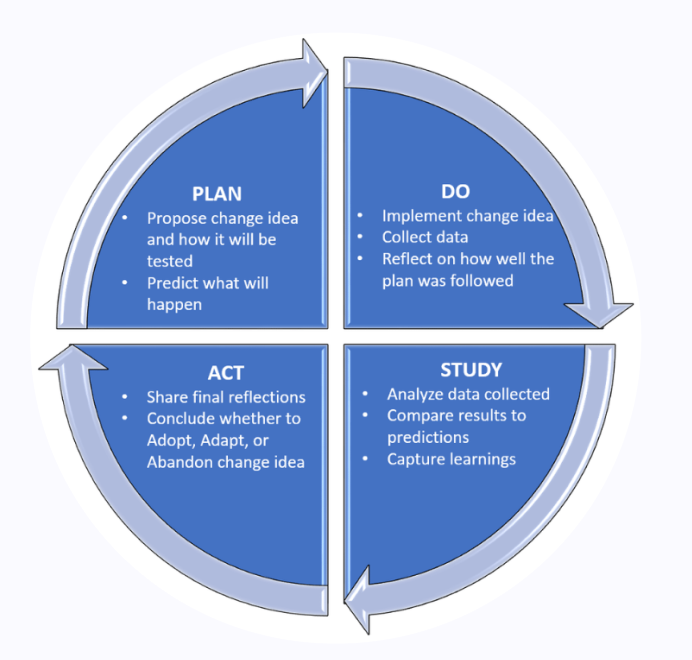
Creating a never-ending cycle for continual learning and improvement.
Through the PDSA you learn your way to a better system:
A series of weekly or monthly tests, striving toward an intermediate goal. The scientific method. With operational definitions. Developing progression in knowledge. Making it visible. Simple. Mathematically precise. Clear to all.
You are either a learning organization or you are losing to one who is.
The PDSA has become the template to improve virtually every type of system or process:
- First, gather evidence to create a hypothesis. What needs to change?
- Second, make the change.
- Third, review what happened. Is the process better or worse? Why?
- Last, decide where to go from here. Revert to before? Iterate further?
In other words:
Put this on repeat:
Step 1:
Set the goal, direction or challenge
What problem are we trying to solve?
What are we trying to learn?
Where does the organization need to go to remain competitive?
Step 2:
Grasp the current condition:
How do we measure against our challenge?
What is our current way of working?
What do I know (that just ain’t so?)
How do I know it?
What is my threshold of knowledge?
Step 3:
Set the next target condition:
Where am I striving to go next?
What obstacles do I need to overcome to get there?
What will I need to learn.
Step 4:
Experiment to overcome obstacles:
Deliberate learning rather than brainstorming and trying lots of ideas
Each experiment is designed to improve or disprove a hypothesis
PDSA: Try, fail, learn, adjust:
Allowing us to keep advancing our knowledge threshold
Threshold of Knowledge: The point at which you have no facts and data to go on.
There is always a knowledge threshold. To see beyond it, conduct your next experiment.
In my 35 years work experience in a variety of industries, I have never witnessed the scientific approach to acquiring knowledge. What I have seen:
Classic illustration of modern management: Red bead experiment.
Deming was a humanist. He believed:
People are entitled to Joy in Work.
His books were written for people living under the tyranny of the prevailing style of management.
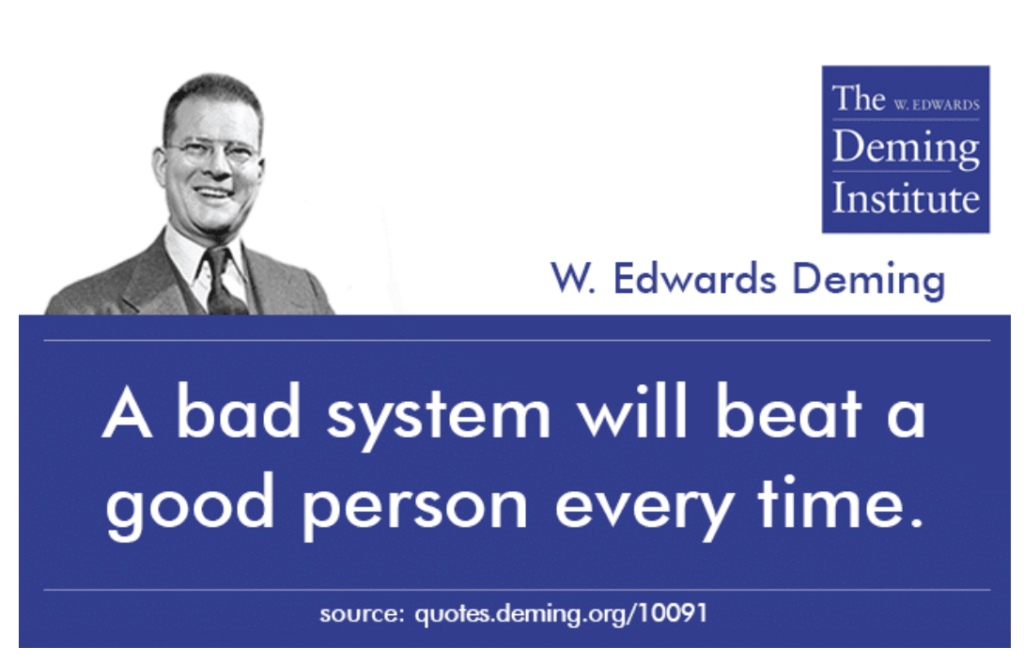
He declared the aim for any organization is for everyone to gain; stockholders, customers, employees, suppliers, community, environment, over the long term.
The ultimate purpose: Continually focusing on improving your products and services.
How else do you set a foundation for excellence?
Transforming a small or mid-size business into a world-class organization, begins with:
- Having a constancy of purpose for long-term productivity gain.
- Plan product and service that will have a market and keep your company in business. Have a common, shared aim. Provide jobs.
- Emphasizing long-term thinking.
- Instead of short-term, investor-led, quarterly pushes to drive financial goals. This is illogical, wasteful, harmful. Not sustainable.
- Instilling the spirit of cooperation.
- Drive out silos, internal competition, merit pay, performance bonus, ratings and grading. Competition is the reason for U.S. decline.
- Driving out fear.
- Stop evaluating performance, merit ratings, annual reviews. They are biased and harmful. Only semi-accurate (with 25 years of data). Understand psychology.
- Avoiding managing with visible numbers only (KPIs, big data).
- Consider the figures that are unknown or unknowable.
- Unleashing intrinsic motivation.
- Remove barriers. Be inclusive instead of exclusive.
- Understanding and define the role of management.
- Adopt the new philosophy.
- Understanding systems thinking and variation, to drive analytical thinking.
- Statistically control to your processes.
- Being proactive instead of reactive.
- Putting out fires leaves you right where you were – at best.
- Developing profound knowledge.
- Take the scientific approach, Plan-Do-Study-Act: PDSA
- Thinking “Win-Win instead of Win-Lose.
- Why increase just your slice? Why not the whole pie? Strengthen your community. Win trust.
- Believing continual improvement is better than “good enough.”
- Why not focus on what went right for a change? Focus on the good and make it better.
The new Mindset:

Cooperation > Competition
Win-win > Win-lose
Inclusive > Exclusive
Systems thinking (to guide analytical thinking)
Continual Improvement > Good enough
Simplicity > Complexity
Results rigid + time flexible
Mentoring > Controlling
Proactive > Reactive
Long-Term > Short-Term
Deming also says that without an aim, there is no system.
In all my years working in a wide ranging of industries, not one company ever had a clear, definitive aim. Think about this.
The list of potential aims is infinite… One person may be striving for client satisfaction. Another just wants to climb the corporate ladder by appeasing the boss. One may be financially driven, by sales, margin or profit.
If you doubt me: Go ask everyone in your organization:
What is the purpose of our business? What is our guiding philosophy? What business are we really in? Why are we trying to do here? What is our core long-term purpose?
My hunch: Everyone has a different answer.
Too many organizations lack a common and shared aim.
Without clear direction, these companies are subject to the soccer metaphor used in:
After polling 23,000 employees, Covey superimposes this metaphor over statistics:
The average organization, if it were a soccer team with 11 people:
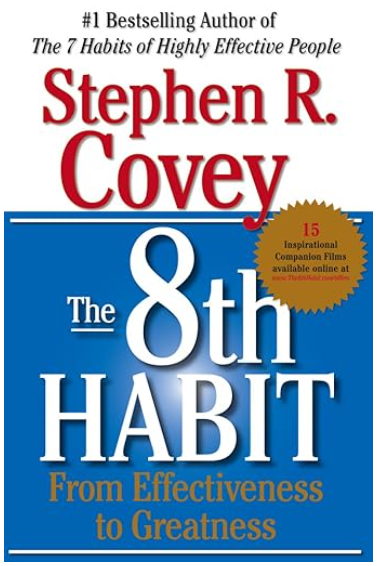
- Only (4) four players would know which goal is theirs.
- Only (2) two players would care.
- Only (2) two players would which position they play and know exactly what they are supposed to do.
- All but (2) two players would, in some way, be competing against their own team members.
Why leave direction to chance?
These a just a few superficial highlights. I am certain your business is absolutely amazing, but
Why stop at good? Do you have no sense of better?
Remember, when it comes to the study of the Deming:

We both know: There is no magic formula. No silver bullet. Nothing delivering 100% guaranteed success.
But if you ask me: Deming’s approach comes pretty damn close.
A word of warning: If you are new to these concepts, please be advised that nothing I am presenting here is in anyway close to a “how to” guide, nor am I treating these concepts comprehensively. These methods require significant expertise and practice to implement. If you are interested in moving forward, you should expect to engage in an extensive learning journey through books, courses, seminars, mentors, and visits to companies that practice these methods.
Who Was W. Edwards Deming?
W. Edwards Deming was a pioneer in the world of business management and quality improvement. Known for transforming industries in Japan and beyond after World War II, he showed companies how to achieve incredible results by focusing on systems, data-driven decision-making, and empowering employees.
What Makes Deming’s Approach Unique?
Unlike traditional management practices, Deming believed that success comes from improving processes, fostering collaboration, and treating employees as valuable contributors rather than replaceable resources. His philosophy is built on these key ideas:
- Focus on Systems: A business is like an interconnected machine—when you fix the system, the results improve naturally.
- Continuous Improvement: There is always room for better processes, higher quality, and greater efficiency.
- Empower People: Employees thrive when they feel supported, heard, and valued. A strong team creates a stronger business.
- Data-Driven Decisions: Success is not about guesswork; it is about using measurable results to guide change.
How Deming’s Principles Benefit Your Business
Deming’s approach helps businesses achieve:
- Higher Productivity: By streamlining processes and removing inefficiencies, you can get more done with less effort.
- Stronger Teams: Empowered employees are more engaged, motivated, and invested in the business’s success.
- Better Customer Satisfaction: Improved quality and service keep customers coming back.
- Sustainable Growth: Businesses thrive when they operate efficiently and create long-term value.
Why I Follow Deming’s Philosophy
I use Deming’s principles as a foundation for every business I work with because I believe they’re the key to sustainable success. Whether it is improving operations, building trust with employees, or creating a long-term growth plan, his teachings have shown time and again that focusing on systems and people leads to incredible results.
If you have never heard of Deming before, you will quickly see how these ideas can transform the way your business operates—and prepare it for a thriving future.
Begin your journey. Please ask Questions:
If you are curious about how Deming’s principles can apply to your business, or if you would like to explore how I can help implement them please reach out. Our work is starving for this information. Let’s collaborate.
Guiding my Mission: Deming’s Approach to Sustainable Success:
According to the Process Fixer: 48% of businesses fail. 70% of the fastest growing businesses fail. Companies designed to reduce variation (Franchises) fail at just 15%. Real world evidence that Deming’s theories may contain master level savvy?
Everybody and their brother should check out Deming’s books, podcast, YouTube videos and website. The world is starving for the revelations he introduced.
If you are a business owner considering selling your company, or simply exploring how to make your operations smoother and more sustainable, I would love to connect. My goal is to honor what you have built while using proven strategies to take it to the next level.

